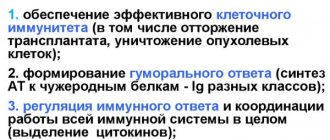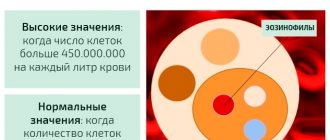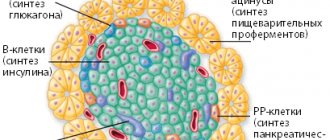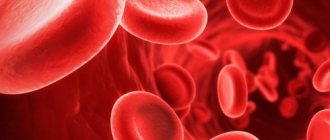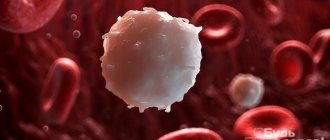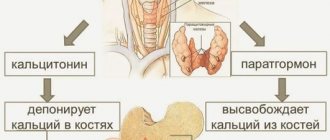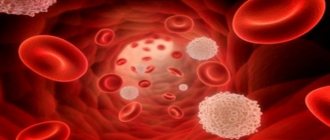Iron deficiency
Worms
Allergy
53085 10 August
IMPORTANT!
The information in this section cannot be used for self-diagnosis and self-treatment.
In case of pain or other exacerbation of the disease, diagnostic tests should be prescribed only by the attending physician. To make a diagnosis and properly prescribe treatment, you should contact your doctor. We remind you that independent interpretation of the results is unacceptable; the information below is for reference only.
Clinical blood test: indications for use, rules for preparing for the test, interpretation of results and normal indicators.
The first microscope and red blood cells
The content of the article
At that time, many people in Holland were engaged in grinding optical glasses to make lenses. Leeuwenhoek also became interested in grinding, and achieved high skill in this matter. Its small short-focus biconvex lenses, inserted into a miniature frame of its own design, gave a magnification of 300 times and a very clear image.
With the help of this simple device, three centuries ago A. Leeuwenhoek was able to see red blood cells - erythrocytes, which perform its most important function - supplying tissues with oxygen, a function without which life is impossible.
Many microscopes made by Leeuwenhoek's hands have survived to this day. Although they are not at all similar to modern microscopes, nevertheless, with their help he not only examined red blood cells, but also formed a correct idea of their size.
Important facts about red blood cells
Red blood cells (from the Greek words erythros - red and kytos - cell) make up the bulk of blood. There are 4.6-5.5 million of them per cubic millimeter in men and 4-5 million in women. And in 5-6 liters of blood circulating in the body of an adult, there are approximately 25 trillion red blood cells!
Unlike other cells, the red blood cell does not have a nucleus; its entire volume is filled with hemoglobin - a red protein, a special respiratory pigment. This protein has the amazing ability to easily combine with oxygen, turning into oxyhemoglobin.
The connection occurs in the pulmonary capillaries, where red blood cells come into contact with the air we inhale. Oxygen-enriched scarlet blood flows from the lungs to the heart, and from there through the arteries to all organs and tissues. Having quickly given them oxygen, hemoglobin also quickly combines with carbon dioxide, forming carboxyhemoglobin.
In the lungs, red blood cells give off carbon dioxide (it is removed from the body during exhalation) and again take oxygen into the lungs. In one day, an adult’s red blood cells carry about 800 liters of oxygen and 200 liters of carbon dioxide.
The shape of the red blood cell - in the form of a biconcave disk - provides a relatively large surface for contact of hemoglobin with gases. It is curious that the total surface of red blood cells is about three thousand square meters, that is, one and a half thousand times more than the surface of our body.
Adjustment methods
The main goal of correcting erythrocytosis is to minimize the number of red blood cells by reducing blood viscosity. In a comprehensive treatment regimen, medications are used that can affect the root cause of the pathology: the condition of the lungs, heart, and blood vessels. The main thing is to eliminate the cause of the pathological condition.
A good result comes from adding a large amount of fresh fruits and vegetables rich in vitamins and microelements to your daily diet. Without them, the synthesis of red blood cells of the correct shape is impossible, which must prevail over all spherical, sickle-shaped, elliptical cells.
Norms of red blood cells
The normal hemoglobin content is 13-18 grams per 100 milliliters of blood, on average about 16. When the necessary tests are carried out in laboratories, this ratio is taken as 100 percent. As a rule, women have less hemoglobin than men, and obese people have more than thin people.
A decrease in the number of red blood cells or a decrease in the hemoglobin content in them leads to oxygen starvation. It happens, for example, to a person who has climbed high into the mountains without special training. He develops the so-called “mountain sickness”: breathing increases sharply, headaches, a feeling of fatigue and a feeling similar to intoxication appear - with nausea, dizziness, and vomiting.
About ten days is enough to acclimatize at an altitude of, say, 4,500 meters. During this time, the body begins to intensively produce red blood cells, and the content of hemoglobin in them increases, and, consequently, the ability of the blood to carry oxygen increases.
This happens not only during acclimatization. Examinations of athletes have shown that in long-distance runners, skiers, cyclists, and rowers, the body's ability to absorb oxygen can double or more. Blood parameters also change accordingly: its volume increases, the number of red blood cells and hemoglobin level increases.
Hematocrit
Hematocrit (hematocrit number), designated as Ht, is the ratio of the volume of red blood cells and plasma in the blood. Either venous or capillary blood can be used for analysis.
Hematocrit in the blood (Ht)
Reference values (norm) of hematocrit in the blood:
| Age | Women, % | Men, % |
| Blood from the umbilical cord | 42−60 | 42−60 |
| 1−3 days | 45−67 | 45−67 |
| 1 Week | 42−66 | 42−66 |
| 2 weeks | 39−63 | 39−63 |
| 1 month | 31−55 | 31−55 |
| 2 months | 28−42 | 28−42 |
| 3−6 months | 29−41 | 29−41 |
| 0.5−2 years | 32,5−41 | 27,5−41 |
| 3−6 years | 31−40,5 | 31−39,5 |
| 7−12 years | 32,5−41,5 | 32,5−41,5 |
| 13−16 years old | 33−43,5 | 34,5−47,5 |
| 17−19 years old | 32−43,5 | 35,5−48,5 |
| 20−29 years | 33−44,5 | 38−49 |
| 30−39 years | 33−44,5 | 38−49 |
| 40−49 years | 33−45 | 38−49 |
| 50−65 years | 34−46 | 37,5−49,5 |
| Over 65 years | 31,5−45 | 31,5−45 |
- Change in hematocrit values
- Hematocrit is increased with erythrocytosis, blood thickening, dehydration, decreased blood plasma volume, peritonitis, renal hydronephrosis
- Hematocrit is reduced in anemia, blood thinning, hyperhydration, increased blood volume, pregnancy
Composition of red blood cells
Over the past two decades, scientists have made particularly great strides in the study of red blood cells. It was possible to determine the structure of the hemoglobin molecule. Not only have all 150 amino acids that make up this molecule been determined, but their location has also been precisely determined.
These data shed light on the cause of a dangerous congenital disease - sickle cell anemia, common in Mediterranean countries. It turned out that this serious illness is caused by the replacement of one of the amino acids in the hemoglobin molecule.
It was also discovered that the deficiency of just one enzyme in the red blood cell leads to intolerance to certain foods and drugs. The results of research at the molecular level expand the possibilities of treatment and prevention of many serious diseases.
Prevention
It is extremely difficult to prevent changes in red blood cell concentrations in men or women. This is due to the fact that, most often, this occurs after the development of the underlying disease. But you can reduce the risk of developing a disorder by following basic measures to maintain health: proper nutrition, giving up bad habits, moderate physical activity and good sleep.
Regularly, approximately once every 6 months, the patient needs to undergo a clinical blood test and a general urine test. This will allow timely detection of deviations from the norm and begin treatment at an early stage of the disease. You should listen to your body and if suspicious symptoms appear, do not delay going to the doctor.
Death of red blood cells
Red blood cells are produced continuously throughout a person's life in the bone marrow of the sternum, pelvic bones and in the long tubular bones of the arms and legs. The process of red blood cell maturation has been well studied. Its duration is 3-4 days. During this time, relatively large bone marrow cells with a large nucleus, containing almost no hemoglobin, multiply through a series of successive divisions. Gradually losing their nucleus, they decrease in size, hemoglobin is synthesized in them, and they turn into red blood cells.
But in the process of their life, red blood cells “wear out”. They live no more than 100-120 days, and then are destroyed and removed from the blood by the cells of the spleen and liver. Every day a person loses an average of 115 million red blood cells per minute. To replace them, the bone marrow produces new ones at the same pace.
Red blood cells, first discovered by Leeuwenhoek, have many remarkable properties. One of them cannot be kept silent about. Factors that determine the group properties of blood were discovered in erythrocytes.
Reticulocytes
Reticulocytes are immature red blood cells containing remnants of RNA and are formed after the loss of nuclei by normoblasts. The number of reticulocytes in the blood reflects the regenerative properties of the bone marrow.
An increase in the number of reticulocytes is observed with increased erythropoiesis caused by blood loss, hemolysis, and adequate treatment of anemia (iron deficiency, megaloblastic).
A decrease in the number of reticulocytes or their normal content in anemia is characteristic of any insufficiency of erythropoiesis (with hypoplasia of hematopoiesis of any origin, including acute leukemia and metastatic damage to the bone marrow, as well as with megaloblastic and iron deficiency anemia, anemia with chronic infections and kidney diseases).
Blood groups
There are four main blood groups. It turned out that the red cells of people of different blood groups differ in the presence or absence of special proteins in these cells - agglutinogens (antigens), designated by the Latin letters A and B.
Some lack antigens A and B (group 1, “universal” donor), others’ erythrocytes contain only antigen A (group II), others contain only antigen B (group III), and others contain both A and B (group IV , “universal” recipient).
Thus, the blood of not all groups is compatible. And if a person is transfused with blood of an incompatible group, a serious complication will occur - sticking (agglutination) of red blood cells, and then their destruction (hemolysis).
Ideally compatible for the recipient (the person receiving the transfusion) is blood of the same group. But if necessary, you can also use the blood of a “universal” donor. A “universal” recipient can practically receive a blood transfusion of any type.
Reasons for changes in RBC level
An increase in RBC levels is called erythrocytosis. And to characterize a decrease in this level there is a term “erythropenia”, which is also known as “anemia”. Erythropenia occurs in people who have a poor diet and do not consume enough vitamins. Or lost a lot of blood due to internal bleeding.
The increase in red blood cells has the following reasons:
- CVD diseases;
- pneumonia, bronchitis;
- blood diseases;
- polycystic kidney disease (or other kidney diseases).
In addition to these diseases, the cause may be ordinary dehydration. Or the use of steroid drugs. If a person takes such drugs, the doctor must be warned about this in advance. Otherwise, the norm will be exceeded for false reasons.
Blood transfusion and storage
Blood transfusion became possible thanks to the discovery of its group properties. Millions of donors regularly donate blood without any harm to their health. Securely packaged and stored in special bottles, it is delivered to all medical institutions in our country.
The problem of preservation and long-term storage of blood was successfully solved, and they learned how to prepare and use plasma and serum. They are convenient because when transfusing them, you do not need to take into account the compatibility of groups. Scientists have found the opportunity to preserve red blood cells under special conditions, which do not lose their precious properties for years.
Blood transfusion, a humane and powerful means of restoring human health, has become very widespread. The blood of donors brings salvation to people.
Three hundred years ago, A. Leeuwenhoek took the first step in studying blood, which in ancient times was considered a symbol of life. Over the next centuries, scientists around the world devoted a lot of effort and energy to putting life-giving medicine into the hands of doctors - donated blood.
ONLINE REGISTRATION at the DIANA clinic
You can sign up by calling the toll-free phone number 8-800-707-15-60 or filling out the contact form. In this case, we will contact you ourselves.
If you find an error, please select a piece of text and press Ctrl+Enter
Preparation for the procedure
Donate blood for analysis on an empty stomach; at least 8 hours must have passed since the last meal. On the eve of the study, it is necessary to eliminate stress (physical and emotional), sudden changes in temperature (bath, sauna), intake of excessively fatty, sweet, spicy foods, and maintain a normal drinking regimen. A blood test is taken before physiotherapeutic procedures and, in agreement with the attending physician, before starting to take certain medications.
In emergency situations, the above rules are offset by the vital need for research, which in such cases is carried out without preparation.

